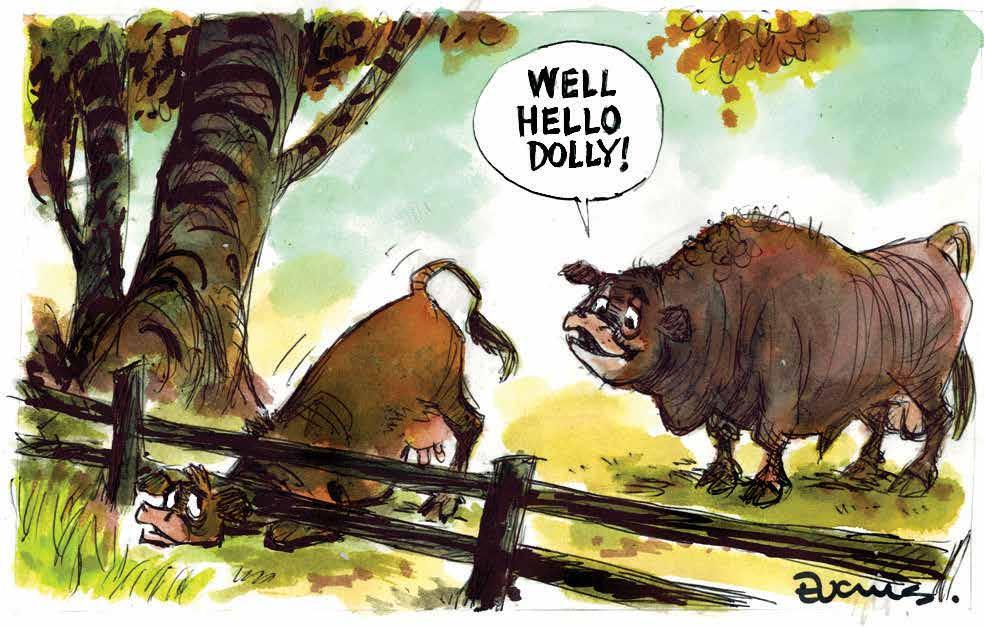








FONTERRA CHAIRMAN Peter McBride says the proposal to reduce the size of the co-operative’s board has unanimous support from sitting directors.
McBride says the board will reduce from 11 to 9 only if farmer shareholders give their green light at the co-operative’s annual general meeting later this year.
“At the end of the day, farmers will decide, and we will respect their decision,” he told Dairy News
McBride doesn’t expect too much opposition to the proposal.
A media report recently named appointed director Clinton Dines and farmer director Leonie Guiney as the directors who could be forced to leave next year to allow for a nine-member board.
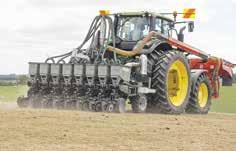
But McBride says nothing will happen until farmer shareholders approve the proposal. Fonterra directors will discuss the proposal with farmers during a round of shareholder meetings planned for later this month.

Fonterra directors retire by rotation; next year McBride and Guiney, who both joined the board in 2018, come up for re-election. Guiney had previously served on the board between 2014 and 2017. Fonterra’s charter states that a director should not serve more than nine years “unless the board considers that special circumstances exist to warrant an extended tenure”.
Guiney, a South Canterbury

FONTERRA SHAREHOLDER and Cambridge farmer Garry Reymer wants Fonterra to include capital structure on the agenda at the next round of farmer meetings.

Reymer believes that the governance and representation as well as capital structure are interconnected, and both are important to the survival of the co-op.
“If we go back first for a bit of history, it was common to have a dairy co-op in almost every small rural centre. When that was the case, the farmers all knew the board personally. They saw them at the footy club, church, school or wherever. They all had active discussions and farmers felt involved and connected. As the mergers took place, this was held together by better transport to larger centres and more regional co-ops with ‘ward’ director, so someone with a close connection to your region.
“Fonterra now has no wards, and four of the eleven directors are not even farmers (appointed by the board) and Fonterra wants to reduce the size of its board.
“To make it worse, from a farmer representation point of view only, the definition of ‘farmer director’ is very loose and if you are a trustee of a farming company you qualify as a farmer director; this can make that director no different from an appointed director.”
farmer, told Dairy News that she supports reducing the board size.
“It’s future focused and will help ensure board dynamics are optimised to best serve our farmer owners,” Guiney says.
She says the recent media story implied “dysfunction in the Fonterra board, which is simply not the case today”.

“Since my re-election to the board of Fonterra, I have experienced a culture that encourages constructive dissent and where all directors’ contributions are welcomed and respected.
“More importantly, the result is better outcomes for Fonterra.”
Under the proposal to reduce the board size, farmer shareholders will remain in control of the board. The current balance between farmer elected and appointed directors would be maintained – with a composition of six farmer elected directors and three appointed directors.
“As is the case today, the chairman would still be selected from within the pool of farmer elected directors,” says McBride.
McBride says as part of earlier governance and representation reviews, a commitment was made to review the board size and composition in 2024.
“Since the co-op’s formation, it has been envisaged that the board size would be rationalised over time.
“With the capital structure review, asset divestment programme and long-term strategy work largely behind us, the board believes it is the right time to review its size and composition.”
THE PRESSURES coming to bear on dairy farming mean a lot of farming businesses are not viable, warns retiring DairyNZ board member Colin Glass.
“They need to really look at themselves and make the changes that they need to, to ensure that they’re going to be here for tomorrow,” he says.
Glass says many of those who grew the industry are now reaching the point of retirement and handing their assets on, but the new generation coming through doesn’t necessarily have the same passion as their parents, and their expectations are quite different.
He has noticed at farmer meetings some “quite divergent” views among farmers of DairyNZ’s role.
“There’s a whole lot of people out there that simply want to be able to carry on doing what they have always done and they’re happy for any advice that they get –so long as it’s what they want to hear.
“We’ve got to realise that we do have to make changes over some things and DairyNZ’s role is not to be there to please everyone. It’s there actu-
ally to lead our industry forward and make New Zealand dairy farming better.”
Apart from the current reset around payout, Glass said there were a couple of “headwinds” facing the industry including getting the He Waka Eke Noa emissions regimen in place.
Getting all the parties of New Zealand agriculture together in broad agreement has been a massive achievement, he says.
And the Government is now starting to realise the unique nature of New Zealand pastoral farming. He says our great strength is growing grass so we are very different to other countries’ largely barn-based systems but that means our biggest challenges will be in man-
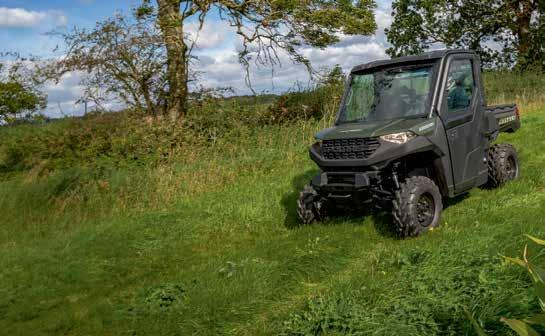
aging greenhouse gas emissions.
Glass says we also have “a very long journey ahead of us” around managing our catchments at a regional level.

“New Zealand’s got some decisions to make. Do we want to de-intensify our farms in provincial New Zealand and move back to a very low touch system or do we actually want to have active and vibrant provincial communities?
“The industry bodies have a key role to play with being involved and representing farmers to ensure that our rural communities can be vibrant and can be profitable into the future.”
Glass spoke to Dairy News on the day voting opened for two open positions on the DairyNZ
board. He is retiring by rotation and has chosen not to stand for re-election.
Looking back on his two terms, Glass is proud that DairyNZ has strengthened as the voice of the dairy industry.
Previously the Government might have gone sometimes to Fonterra for matters affecting the industry, and sometimes to some other organisations.
“So, the thing that I’m quite proud of within DairyNZ is that it’s become the go-to organisation over the last six years,” he says.
“I’ve seen DairyNZ get very close to MPI, and closer than it was with MfE [Ministry for the Environment] in Wellington.
“So the Welling-
AS THE only South Island representative on the DairyNZ board, retiring member Colin Glass says it would be good for another South Islander to be elected in the voting now underway.
With both Glass and board chair Jim van der Poel retiring by rotation, there are two vacancies to be filled. Van der Poel is standing again but Glass is not.
Thirteen candidates are standing, and Glass says it’s not his place to endorse any one.
“But look, I’ve worked alongside Jim for my whole time on the DairyNZ board and I can’t speak highly enough of him.
“He’s always had a very strong passion for farmers and for the industry.”
Glass says he’s not met anyone in a similar role willing to put in the time and effort that van der Poel does.
“I think he does an outstanding job.”
But there are some other good candidates, he says.
“I think it’s really important that the South Island view is heard and the awareness out of the South Island is put forward.”
Glass says it’s not often recognised that about 48% of New Zealand’s milk supply now comes out of the South Island. Canterbury’s contribution is larger than the Waikato, and Southland’s larger than Taranaki, he says.
“So, it’s no longer about the importance of Waikato. It’s now very much about the importance of the South Island, and what’s sustainable and achievable down here.”
Four of the 13 hopefuls are from the South.
ton connections I think have really grown quite strongly over that time. You could probably argue that M. bovis has been the catalyst for that.”
Glass says the M. bovis programme is well on the way to success.
“But for me the big success is that Government, Beef+Lamb and DairyNZ have been working closely for the first time ever.
“When you step back and you look back over those six years and you see what’s playing out there, MPI I think have gained a healthy respect for industry and industry equally have become aware of the challenges that MPI have to work through.
“I’d argue that wellington was very disconnected before the M. bovis response.”
Glass, the fulltime CEO of Dairy Holdings, said his time on the board had been a great journey but increasingly a juggling act while both his own business and Dairy Holdings kept growing.

“So after six years on the DairyNZ board, I felt that I either need to step up into a bigger role there or it’s time for me to move on and look at the next thing.
“The sheer time commitment I’ve got within our own business and Dairy Holdings, that was really demanding.”
With his wife Paula (herself a part-time accountant with Dairy Holdings) Glass runs a dairy and dairy support business across three blocks just south of Methven.
“This is what we do in our spare time,” he jokes.
The business consists of a dairy farm currently with 670 milkers, a home block and another where they rear about 500 bull calves to be sold as twoyear-olds either for beef or as dairy service bulls.
They used to graze heifers and wintering cows off-farm but as of this year are keeping them at home.
Already the biggest dairy group in the country, Dairy Holdings now boasts about 57,000 milking cows.
NEW ZEALAND dairy farmers are facing uncertain and complex times, says Rabobank’s senior agricultural analyst Emma Higgins.
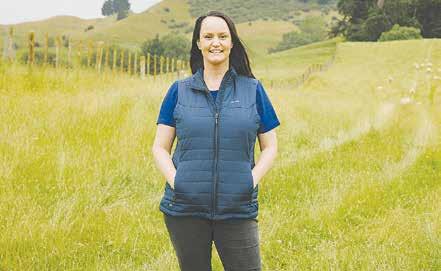
And she says there’s more pain to come before things start to settle down.
The heart of the issue is China, which is taking longer than predicted to come out of the woes caused by Covid 19. She says, when it comes to the farmgate milk price, this season there will be more discomfort for dairy farmers. She adds that while there are rays of hope, these are some way off.
“The Chinese market is still sluggish,” Higgins told Dairy News
ASIDE OF the China situation, the major global dairy exporters, including NZ, are also facing challenging times.
The growth in dairy production in places such as the US, Europe, Australia and South America is slowing and is likely to help offset sluggish demand for dairy, and lead to a ‘balancing of the global dairy sector’.
Emma Higgins says Rabobank believes, for example, that in the coming season milk production in NZ will decline by 0.7%. She says for China to come back fully into the market, overall world milk production needs to decline.
She says worldwide dairy farmers are struggling to achieve profitability, and in the case of the United States, slaughter rates for cows are higher than normal.
“The economic headwinds within China and the economic growth expectations for China are shrouded in uncertainty right now and so what we think is that a strong demand recovery
NZ dairy farmers, says Higgins, are caught up in this global dairy turmoil and this is translating into uncertainty. There is the prospect of the farmgate milk pricing moving up or down depending on what transpires in the future.

She says the fact that less milk is going to be produced in NZ this season may help. Outside the global issues, another concern has been raised – the weather. There are fears that the El Nino weather pattern may bring a drought.
“I acknowledge it’s particularly challenging for dairy farmers right now, especially if you overlay some of the production challenges they are having right now right during calving. But the good news is that the pain won’t last forever,” says Higgins.
is not likely.
“What we are talking about going forward is that positive imports into China are not expected until next year at the earliest,” she says.
Higgins says there are
several factors at play to the challenges that China is facing.
These include dwindling demographics, property price pressure and high debt levels.
She says which-
ever way you slice the data, demand for dairy in China has been far weaker than supply growth. Until this is resolved, the problems are likely to continue. On the positive side, she says in the last quarter, China has been buying product.
“But it’s less than what they have historically done, but at least
they are buying,” she says.
On the other side of the world, one of the biggest importers of dairy products, Mexico, remains a strong buyer.
The other positive, says Higgins, is rising demand in other parts of South East Asia, tempered by the fact that South East Asian coun-
tries heavily dependent on tourism were badly hit by Covid.
“What we have seen transpire over recent times is their food service industry has started to recover, which has been great, but the next challenge is the cost of living crisis and the impact that has for dairy demand,” she says.
Emma Higgins, Rabobank says there’s more pain to come before things start to settle down.
Dairy farmers know how vital it is to keep their sheds and herds clean and free from contamination. No one can afford to have their milk down-graded. Make sure your products are put in front of the nation’s dairy farmers by advertising in this report.
THE COUNTRY’S best ice cream maker says it’s the quality of the ingredients that makes all the difference to his products.
Patagonia Chocolates co-owner Alex Gimenez says quality milk and cream originating from New Zealand farms is a factor.
“Definitely, the difference is the quality of the hazelnuts we use, mainly from Central Otago and Canterbury,” he says of the Hazelnut Cremino ice cream, adding that the nuts are roasted, ground and refined in-house “to make the most beautiful hazelnut paste I’ve ever tried”.
“Of course, using the best quality New Zealand milk and cream helps
as well, making our ice cream a beautiful one,” he told Dairy News
Patagonia Chocolates, a boutique ice cream maker and chocolate shop based in Otago, won big at this year’s New Zealand Ice Cream & Gelato Awards.
As well as scooping the Formula Foods Supreme Champion –Boutique Award for its Hazelnut Cremino ice cream, Patagonia also picked up a gold and a silver medal in the Chelsea Sugar Premium Ice Cream category.
The boutique ice cream store also picked up two gold medals for its Hazelnut Cremino and Dulce de Leche ice creams in the PACT Packaging Champion Standard Award. Chief judge Jackie Matthews noted that the base of New Zealandgrown, hand-roasted nuts
provides a “delicate and truly authentic flavour, which combined with a superbly crafted and wellmade ice cream is simply stunning, deserving of the Supreme Award”.
The company’s story starts in 2005 when Gimenez and fellow coowner Lorena Giallonardo longed for the chocolate of their Argentinian homeland. So, they
opted to make it themselves, selling the chocolates to their local community in Arrowtown.
Since then, they’ve expanded both the range of products available, introducing ice cream and coffee to the menu, and the number of locations, having since opened stores in Queenstown and Wanaka, including its Queenstown Ice Creamery & Chocolaterie which offers customers the opportunity to create their own ice cream sticks and a chef’s cabinet full of desserts.
Gimenez says the team is “extremely happy” about winning the award.
“We are a small team of very passionate people and winning the supreme award is showing us we are in the right direction,” he told Dairy News
KIWI ICON Tip Top has topped multiple categories in the recent NZ Ice Cream & Gelato Awards 2023.

The company took out five trophies, including the Davis Food Ingredients Champion Novelty Ice Cream Award, the Pacific Flavours and Ingredients Kids’ Choice Award, the NZ Life & Leisure Low Fat & Frozen Yogurt Award, the Invita NZ Champion Open Creative Award, and the Chelsea Sugar Premium Ice Cream Award.
A newcomer to the trophy is Americold Supreme Champion Commercial winner, Allied Faxi New Zealand Food Co which won for its G’nature Vanilla Ice Cream.
Allied Faxi, a Chinese-owned maker that reopened the Kerepehi cheese factory in Paeroa in 2016 to make the G’nature brand, was also awarded the awarded IMCD & Givaudan Champion Premium Vanilla Ice Cream Award.

“This classy ice cream has an uncompromising depth of flavour, is rich and creamy and succeeds perfectly in its mission to deliver a super smooth vanilla flavour,” the judges said.
A panel of 20 food judges, led by chief judge Jackie Matthews, evaluated each entry over two days in late July.
After careful deliberation, they decided upon the 16 Trophy winners and 183 medal winners.
Matthews says the 2023 entries met a high standard for ice cream.
consistently outselling other farm bikes in its class. And with this great offer, it’s set to continue.

Talk to your Suzuki dealer today.

DESPITE THE Cana-
dian Prime Minister Justin Trudeau swanning around the world claiming his country supports rules-based trade – he said this just a few days ago – the fact remains Canada is regarded globally as one the world’s most protectionist economies.
Tariffs as high as 300% are a manifestation of this and dairy is one of the sectors that benefits most from this policy position.
This view is echoed by Kimberly Crewther, the executive director of Dairy Companies Association of New Zealand (DCANZ), which represents most NZ dairy com-


panies. Crewther says Canada is highly protectionist and has sought to actively undermine the access that NZ gained legitimately through its membership of CPTTP. She says not only have they blocked their market to exporters such as NZ, Canada also subsidies its exports.
“Canada is a G7 economy that does value dairy within its diet and is very active outside the dairy industry in terms of global trade,” she told Dairy News
“Canada operates a supply managed system where they have quotas for production, set prices for the milk and then seek to manage their market so that the production equals the demand, rather than enabling their market to
balance itself. This has the effect of excluding exports,” she says.
Crewther says there is the opportunity for NZ to export to Canada if the trade barriers were lifted. Interestingly, three Canadian importers of dairy made submissions in support of NZ’s case to the panel hearing the dispute.
Behind the scenes, DCANZ and Fonterra provided supporting information to MFAT for its case against Canada.
Crewther said they provided a submission outlining the challenges the NZ dairy industry faced as a result of Canada’s action and pointed out the financial upsides to NZ if they were allowed to trade as per the CPTTP rules.
“An awful lot of work was involved in taking
A WARNING to New Zealand: don’t hold your breath about Canada rushing to open its market to our dairy exports. This is even though NZ scored a landmark legal victory which forces Canada to put an end to protectionist policies that favour its dairy sector at the expense of NZ. Such policies are against the rules of the CPTTP – the trans-pacific trade agreement of which Canada and NZ are both signatories.
Under this agreement, countries are expected to open their markets to fellow members of the CPTTP, but despite three years of political pressure from the NZ Government to abide by the terms of the FTA, Canada has steadfastly refused to do so, thus breaking the rules of an agreement they signed up to.
It has done this by way of retaining a complex illegal quota system for dairy products which favours their own farmers and processors and effectively excludes exporters such as NZ. It’s estimated that Canadian intransigence over complying with the CPTTP has already cost NZ$120 million and will cost even more until they comply with the decision of an independent panel that ruled on the NZ case.
While Canada and NZ enjoy a close friendship and a positive relationship in most areas, the Ministry of Foreign Affairs and Trade (MFAT) decided to take legal action against them using provisions in CPTTP to settle disputes. This is the first time NZ has taken a case against an FTA partner and won.
While one might have expected Canada to do the honourable thing and sort the problem out immediately, offi-
cials believe Canada will drag the chain and take the full 15 months it has to open up their market to NZ dairy products.
MFAT’s deputy secretary trade and economic, Vangelis Vitalis, says NZ dairy exporters have not been able to benefit fully from the market access that was agreed. He says importers interested in buying NZ product have been unable to access quota and this represents a tangible cost to us and other exporting CPTPP Parties. He says the rules exist to address situations exactly like this.
“Putting it frankly, Canada’s approach to administering its dairy quotas is protectionist and undermines the market access agreed between CPTPP Parties. The Panel made it clear that all importers must have the opportunity to utilise Canada’s TRQs fully and Canada is not allowed to use administrative complexity to prevent importers accessing quota, or favour some importers over others. Canada must comply with the outcome, and it must not simply recraft its approach,” he says.
As well as sending a strong message to Canada, NZ’s win at the legal table is seen as precedent setting. And officials see this as sending a strong message to other countries with FTAs with NZ that we will not be bullied or ripped off by any country, regardless of its size or status. It is also seen as sending a strong message to farmers and exporters that MFAT and the Government is on their side and will act decisively in their interests if anyone breaks the rules.
– Peter Burkethis case –the incredibly hard working and dedicated teams across MFAT and MPI who have got us to
this point – and we are really grateful for their efforts.”
Fonterra was also operating behind the
scenes in support of the NZ case. It has a staff member in Canada who interacts with importers and made sure they were aware of the CPTTP provisions. In a sense, Fonterra had a trump card in Simon Tucker who is their director, global sustainability, stakeholder affairs and trade, and a former High Commissioner to Canada, but has also worked for DCANZ and DairyNZ.
He says Fonterra has customers in Canada interested in buying from them.
“We will be looking for opportunities to utilise those quotas to fill that customer demand in Canada and the quotas are valuable in that sense – especially for high value butter and cheese. I think there are also opportuni-
ties in the protein space,” he says.
While the Canadian Trade Minister, Mary Ng, has bizarrely claimed they are winners by getting support for minor pushbacks in the panel’s judgement, the reality is NZ is the clear winner in this dispute. Canada has been trumped and all the spin in the world will not save them.
Perhaps they and others who trade with NZ need to realise that small countries can use the rules to their advantage to, says Crewther.
“It’s important that we continue to invest in trade liberalisation and when we get trade liberalisation it is important that we make sure we maintain these opportunities in reality, not just in paper,” she says.
I already have my feet under the LIC board table and know the business inside LIC is my sole focus as Director and I am committed to ensuring LIC keeps performing for With the industry going into a downturn and governance transition within LIC, farmers need the experience and continuity of an incumbent board member.
25th - 29th September
Come along to a farmer meeting next week in your area. We’ll celebrate all your hard work, plus have a conversation about the Co-op’s performance and outlook.
Your Directors and Management Team will be on hand to discuss our results and strategy. We’ll have light refreshments on offer, including delicious cheese made with your milk. There’ll be plenty of time for Q&A and networking. Visit the URL below for more information on dates and times, and to RSVP.
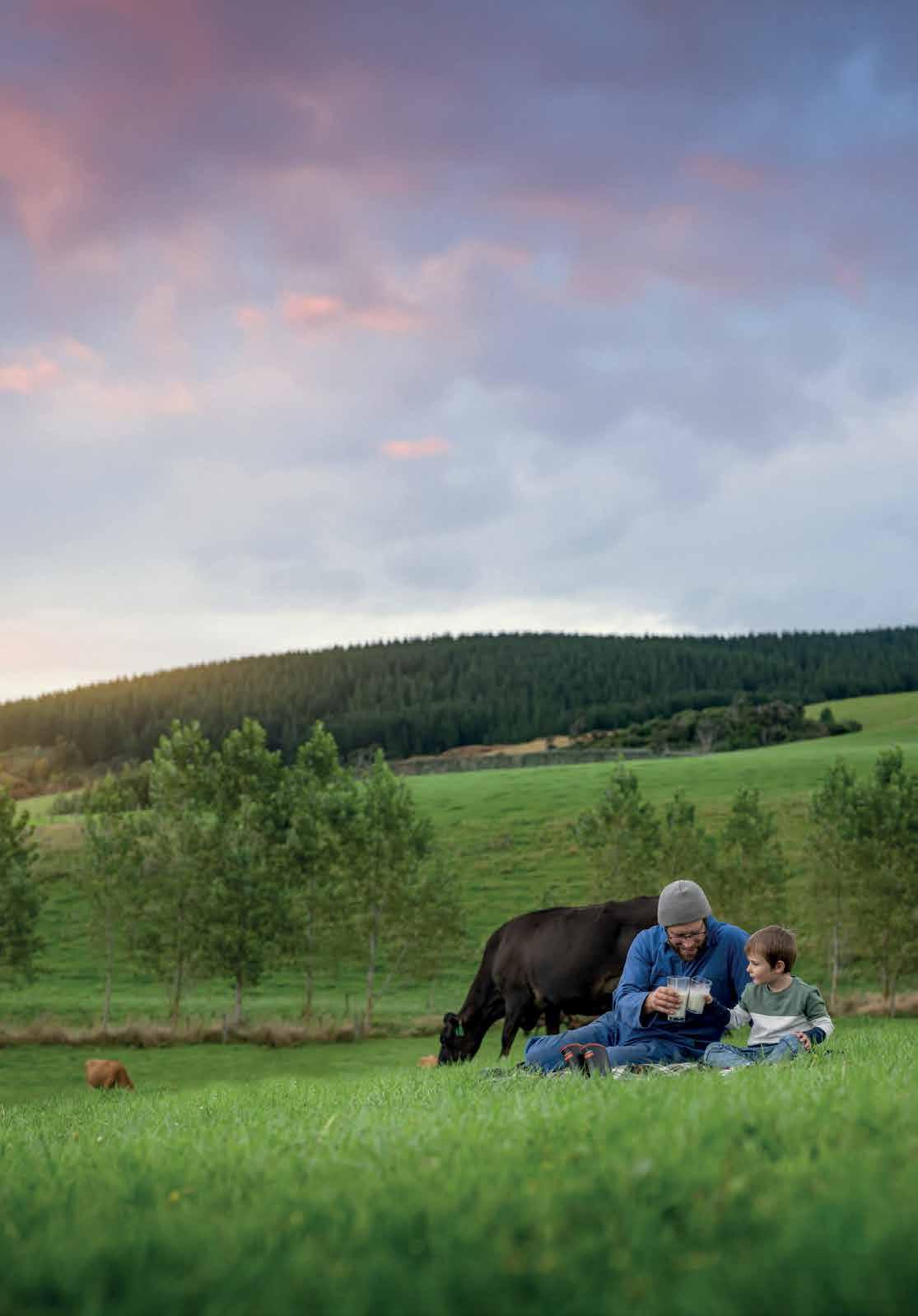
SCIENTIFIC DATA col-


lected across five catchments over the past 20 years show improvement in surface water quality.
Researchers found that, over the 20-year monitoring period, including post-extension, 70% of in-stream water quality trend directions were improving or showed no change. The median levels of most contaminants in water have also decreased, due to farmers implementing good management practices (GMPs) such as improved effluent management and stock exclusion.
The study found in-stream concentrations of phosphorus and suspended sediment decreased the most in response to on-farm work.
Overall, the research shows the implementation of GMPs on-farm does improve water quality.
nepi (Waikato), Waikakahi (Canterbury), Bog Burn (Southland) and Inchbonnie (West Coast) catchments to assess whether on-farm actions have helped improve water quality over time.
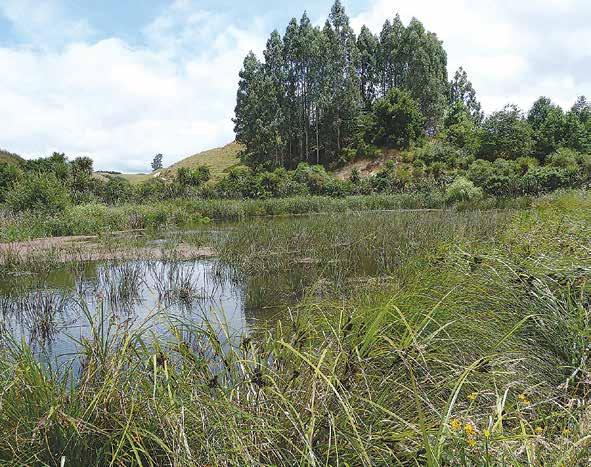
The five catchments are dairy farming areas that were part of the 2001-2010 Best Practice Dairy Catchments project, which monitored water quality and environmental work on-farm.
Monitoring of water quality and changes to farm practices continued from 2011-2020, as part of national long-term data collection.
DairyNZ general manager sustainable dairy Dr David Burger says the analysis shows the good outcomes achieved by improving management practices on dairy farms.
“The mitigation options dairy farmers can take to reduce footprint are widely known, but analysis of the posi-
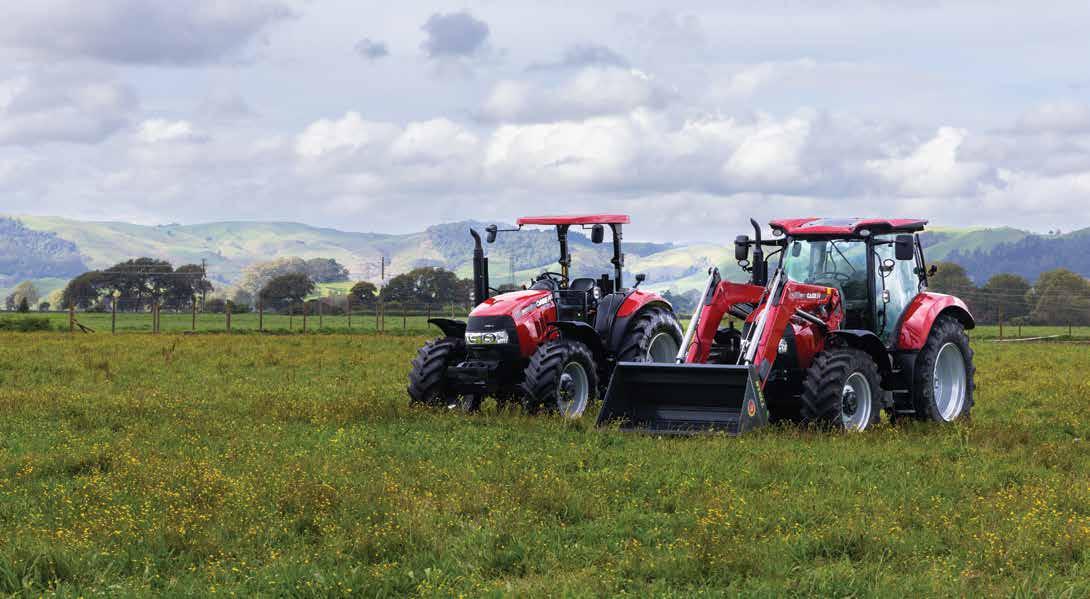
Research lead and Our Land and Water National Science Challenge chief scientist Professor Rich McDowell
know nitrogen levels increased in many catchments due to development on other dairy farms over the same
quality expectations,” he says.
DairyNZ continues to work with farmers to develop on-farm practices, provide a scientific evidence base to help inform practical and fair regulations and demonstrate the positive results of the actions farmers are taking to improve the health of waterways.
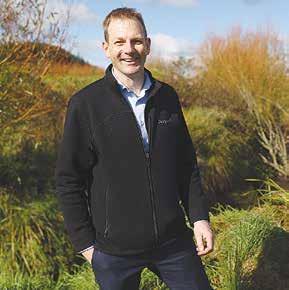
Farm environment plans identify actions to improve water quality, reduce greenhouse gas emissions and increase biodiversity, and are tailored to individual farms. Currently, more than 70% of New Zealand dairy farms have farm environment plans and 45% have greenhouse gas farm plans. By 2025 all farms will have both plans.
“The dairy sector is committed to sustainable dairying and farming within environmental limits,” Burger says.
“Through the Dairy Tomorrow Strategy and
LIC business focused on its core mission.
SUDESH KISSUN sudeshk@ruralnews.co.nzHERD IMPROVEMENT
company LIC’s director elections have attracted a high calibre of candidates.
For the North Island seat, incumbent Ken Hames is up against three candidates: Ballance board chair Duncan Coull, agribusiness leader Matthew (Mat) Hocken and Tatua director Richard Luxton.
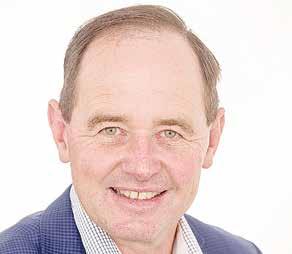
For the South Island seat, to be vacated by retiring chairman Murray King, a three-way battle is on between farmer and company director Tony Miles, Selwyn farmer and South Island Dairy Event (SIDE) chair Andrew Slater and farmer and company director Victoria Trayner.
Coull, a former chair-
man of Fonterra Co-operative Council, says for him, governance is not a career choice but an opportunity to contribute, give back and serve the industry that has and continues to treat his family well.

“I’m a passionate believer and 100% loyal to the cooperative model being the most aligned to the collective needs of our farmers as customers and shareholders.
“However, the cooperative model only works when the culture within an organisation is reflected in both relationships with customers and shareholders.
“LIC’s board composition has undergone some change over the past few years. We are losing some key experience. Board composition
He notes that the low milk price forecast combined with cost inflation and high interest rates is putting pressure on farmers. LIC must be proactive and agile to help shareholders manage these challenges, he says.
“NZ has some of the most carbon efficient farmers in the world.
LIC must deliver productive, sustainable and carbon efficient genetics that support farmers to provide consumers with more food, from a smaller footprint.
“LIC is well placed in genetics and herd management in NZ. It must continue to innovate to provide world-class services, and support
improve productivity and efficiencies through data capture, management and reporting systems.”
Luxton says he understands and appreciates the importance and value good breeding and standardised data can bring to the industry.

“I have extensive dairy experience across the value chain through my past and current involvement in: farm management, sharemilking, farm ownership, corporate farm management, corporate farm governance as well as dairy processor governance.
lenges we face now and those that will come into the future.”
Miles says as a dairy farmer, a business coach and someone who is passionate about the dairy industry, he is constantly working to create better businesses every day.
“It is critical that LIC continues to have a strong balance sheet, so the company is well resourced to invest in new technology and inno-
governance, business experience, strategic thinking and a large network of clients, mentors and contacts, provides me with valuable insights that will add value to the board, bringing positive change, growth and opportunities for the company.”
Slater notes that at the heart of LIC’s strategy is ‘Value for our farmer shareholders’.
“A simple statement that needs to be at the forefront of very discussion and decision around the board table,” he says.
“Supporting a sector that leads the world, LIC needs to ensure it provides innovative products and services that enhance our herds productivity while meeting increasing regulatory and customer driven demands while delivering information and technology to ensure our operational
1993

Nelson Bays & Marlborough
Oct 22, 2023 6 Days
Stay in sunny Nelson & Blenheim. Enjoy a Queen Charlotte Sound cruise, lunch & wine taste at Seifried winery, a Greenshell Mussel Cruise. Visit Motueka, Kaiteriteri, Abel Tasman National Park and Pupu Springs. Train to Omaka Aviation Centre.

Forgotten Highway & Taranaki
Nov 7, 2023 + Feb 13, 2024 6 Days
Visit Hobbiton, travel 40km by Rail Cart into the Forgotten World - 10 hand dug tunnels and over 25 bridges. New Plymouth sightseeing tour, cruise aboard Paddle Steamer Waimarie, then Northern Explorer train back to Auckland.

is critical in any organisation in having the balance between enthusiasm and experience.”
Sitting director Hames believes that as LIC transitions to a new chair, it is important that there is stability around the board table to ensure effective governance.
He says as a board they have introduced the three commitments which has been an effective way of holding management to account for delivery on issues that are important to shareholders.
farmers to continue to innovate on farm.
“Farmers increasingly require integration of data to run farms productively and communicate with stakeholders.
LIC must develop and work with others to capitalise on data intelligence and enable farmers to
“We are fortunate to have a co-operative with a strong balance sheet, world leading genetics, data collection and excellent management in place.

“Change is coming at us fast – be it increasing farm operating and debt servicing costs, environmental legislated change, or changes forced on us by our consumers. LIC is well positioned to help its farmers through the chal-
LIC DIRECTORS and shareholders reference group (SRG) members could be in for a pay rise.
The LIC honoraria committee is recommending a lift in allowances, which farmer shareholders will vote on.
vations to improve efficiencies and profitability in a sustainable manner for our farmer shareholders.
“Linking practical dairy experience with
decisions are not only environmentally sustainable, but financially sustainable now and into the future.”
Trayner believes she has relevant corporate experience that would add value to the LIC board.
Bonded for Your Protection
These include improving customer and stakeholder engagement, further investing in technology and platforms which offer an improved farmer experience with MINDA, driving genetic gain and investing strongly in R&D while delivering a well-run business with a steady dividend stream.
Hocken says if given the opportunity to serve as an LIC director, he would work hard to maintain and improve a strong
The committee recommends that the chair’s remuneration increase by $11,000 to $143,000 annually. Director fees will jump $6,000 to $65,000.
The four-member noted that the honoraria currently paid to LIC directors is not sufficient to maintain relative remuneration parity with similar organisations.
“Therefore, it has the potential to put pressure on LIC’s ability to attract and retain good governors.”
The committee says it feels that the current level of remuneration does not fully recognise the time and commitment required to be a director of LIC.
It is imperative that LIC maintains a high calibre of directors on its board, the committee says.
“Elected directors bring a strong understanding of the co-operative, the New Zealand dairy industry, as well as the challenges ahead of the industry.

“Appointed directors bring to the board a balance of skills and experience relating to international markets, mergers and acquisitions, health and safety, technology, finance, risk and they often have exposure to other complex businesses. The aim of the honoraria committee is to ensure that directors’ remuneration is relevant and includes some recognition of potential opportunities foregone to them, while being sufficient to attract and retain good governors.”
LIC has six farmer-elected and three appointed directors.
The honoraria committee recommends that the SRG chair’s fees rise $3,500 to $40,000, deputy chair to get a $2,000 pay rise to $17,000 and SRG members get $14,000 – an extra $1,400 per annum.
“What adds value to a company and to the economy, is growing revenue more quickly than costs are increasing.
“Shareholders are facing this in their own business, and I see LIC has an important role to continue to expand its production frontier.
“I am really excited about the possibilities LIC must add value to the value chain for its, farmers, shareholders, customers, and stakeholders now and into the future.”
Voting is underway and results will be announced at LIC’s annual meeting in Ashburton on October 12.

AGRONOMIC TOOLS
and practices are available for maize growers facing the headwinds of increasing costs of production, extreme weather events and environmental considerations, Foundation for Arable Research senior maize researcher David Densley says.
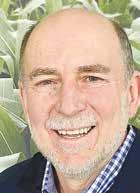
While nitrogen fertiliser prices have eased from the peaks of the last two years, these are still a significant contributor to the cost of maize production, says Densley, who led a series of FAR winter maize workshops throughout the North Island and in Canterbury.
For the 2023-24 maize production season, the projected total fertiliser cost is forecast to reduce by almost $390/ha compared to last season. Fertiliser costs are projected to fall to 43% of the total
cost of production, compared with 51% in 2022/23, using information from the Pioneer Maize for Silage catalogue. Nitrogen is expected to make up 40% of the total fertiliser budget in the 2023-24 season down from 475 the previous year.
While production costs for maize silage have increased on average by $51/ha a year over the last 26 years, since the 2019-2020 season this rise has jumped to $270/ ha/annum.
Total maize silage growing costs are predicted to be about $3,438/ ha, slightly down on last year.
Farmers can save money in nitrogen (N)
costs as well as make environmental gains by making better use of plant available N naturally present in the soil, Densley says.
Rather than applying a standard amount of nitrogen fertiliser, growers are encouraged to
measure how much N is in the soil (using a MinN test), as well as what might become available during the growing season (Potentially Available N) and take this into account when determining crop N fertiliser requirements. As well as
reducing the risk of N leaching, N fertiliser is the main source of greenhouse gas emissions from a maize crop which government plans to tax.
“A lot of people are soil testing, but most people aren’t using this information to determine
their N fertiliser application rates.
“Our research suggests that even after longterm maize production there can be a significant amount of mineral N in the soil available to the maize plant.
“Measuring mineral
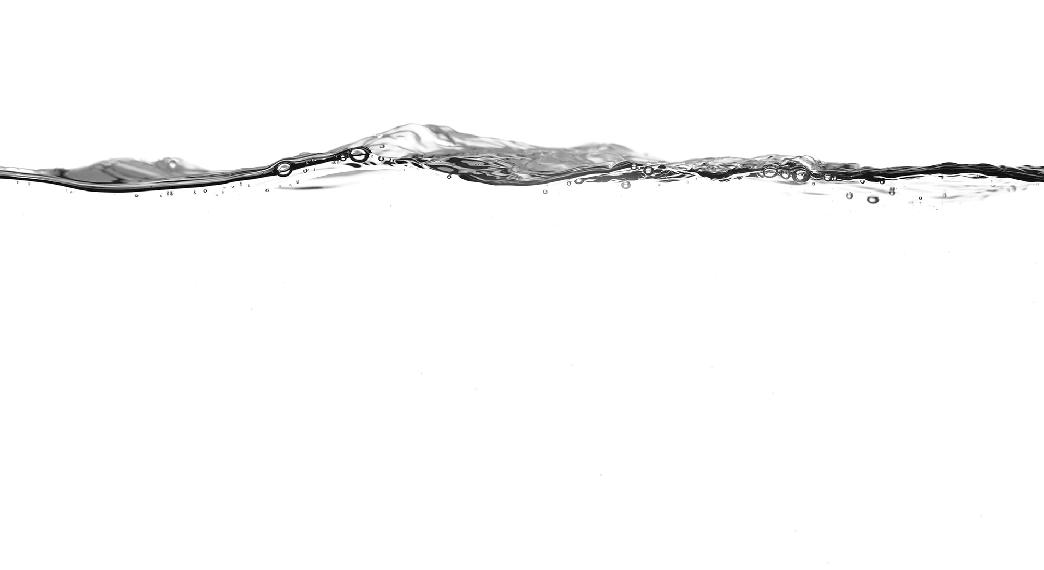
N ahead of side dressing provides the opportunity to reduce input costs without compromising yield.”
As soil mineral N levels are variable across a field, consideration should be given to where samples are collected, he says.
The amount of N which becomes available during the growing season can be significant, so it is also worth measuring for Potentially Mineralisable N.
In terms of agricultural emissions, benchmarking of 20 maize systems showed average annual GHG were 2 tonne CO2e/ha for grain. Silage is higher at 3.5t CO2e because of the influence livestock have on emissions within the production system.
NEW ZEALAND’S recommended
maize planting rates have flatlined, while in the US, these continue to increase on an annual basis.
So, why isn’t New Zealand following the US trend?
For the last 15 years, recommended planting rates for medium to long maturity maize silage hybrids in New Zealand have remained static at between 105,000 and 110,000 a hectare. Maize grain planting rates have lifted marginally to just above 95,000/
ha. In comparison, US Department of Agriculture data shows that maize planting rates have increased on average by 900 seeds/ha a year since the 1960s, doubling from 40,000 to 80,000/ha. Over the same timeframe, maize grain yield has continued to increase on average at a rate of about 125 kg/ha/year. Many in the US believe that this increasing trend in plant population will continue well into the future.
The US yield increase is attributed
to genetic gain, agronomic improvements and increasing plant population. Maize grain is a massive crop in the US, with 32 to 36 million hectare planted each year.
Foundation for Arable Research senior maize researcher David Densley told growers at a series of winter maize workshops that maize silage and grain seeding rates have more or less remained static since the inception of maize production in New Zealand in the early 1990s.
“Some research and commercial observations suggest that under current management practices and climatic conditions, seeding rates may be about right.”
David Densley asked those attending the workshops as to why they believed recommended seeding rates have more or less remained flat despite increases overseas.
Some suggested that in the US they were starting from much lower densities and are only catching up
to New Zealand seeding rates, while some thought farmers are possibly deterred by the cost of the additional seed required. Higher planting rates mean a higher yield is required just to break even on costs.
Factors in New Zealand that support higher populations include a maritime climate, which results in lower overnight temperatures than those experienced in the US. New Zealand’s soils also contain much higher organic matter.
• For Water Storage Tanks
• Adjustable levels from 50mm-2.5m
• Minimises pump operation

•Available in 20/25/32/50mm
• Stainless steel bracket and Shaft


• Fits plastic and concrete tanks

• Rugged and long lasting
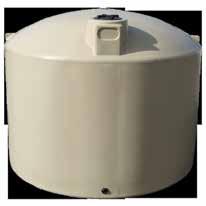
WITH THE election looming, both Labour and National have proposed huge cuts from public sector spending.
Milking It is all in favour of these cuts, given the blow out in spending for what looks like a poorer result all round. But, it has been noted – by communications and government relations consultant Gwynn Compton – that the ‘neutral’ Council of Trade Unions (CTU) and the Public Service Association (PSA), whose priority should be workers’ rights, have been very selective in their criticism of said cuts, depending on which party had proposed them.
For example, the PSA “thundered with outrage” at National’s cuts, but in response to Labour’s, said public servants “must help identify savings”. Does this partisan approach by the unions really serve their members?
WAIKATO’S NEWEST milk processor, Olam has poached one of Fonterra’s biggest milk suppliers in the region.
Milking It understands that the family-owned business, based in Te Puke with farms in the Bay of Plenty, Central Plateau and Taumarunui areas, is sending some of its milk to Olam’s new factory in Tokoroa.
The plant, owned by Singaporean conglomerate Olam, has been signing up suppliers for the past year. The new milk plant is due to start processing milk later this year, Olam used to own a cornerstone stake in Open Country Dairy but sold it to the Talley’s Group, who own Open Country.
FARMERS HAVE been slapped with another rise in levy.
Ospri has decided to lift the TB differential slaughter levy from next month by $1/head.
The timing adds further pressure to farm businesses currently challenged by the reduced milk price, rising interest rates and record input costs.
The control and eradication of bovine tuberculosis (TB) is a critical risk management initiative. It works to ensure TB does not pose a threat to the health of our cattle herds, those working with them or the viability of our dairy and beef export sectors.
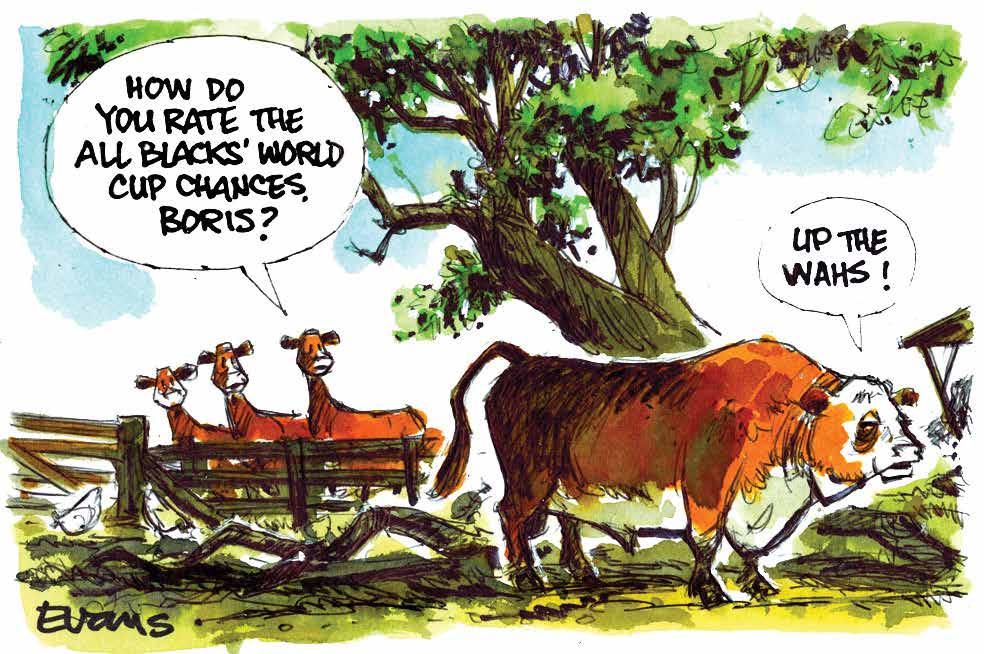
DairyNZ is the majority industry investor in TBfree’s national tuberculosis (TB) control programme and this is the single largest investment from the milksolids levy.
However, DairyNZ’s concerns around the levy hike fell on deaf ears, it seems.
WHILE THE champagne corks have been popping in New Zealand with our victory over Canada at the latest CPTTP outcome, in Canada, humble pie might be the order of the day.
And with that humble pie, maybe a few large dollops of their subsidised dairy products will help make it a bit more palatable. Seriously, Canada’s actions are weird, to say the least.
Why saunter around the world saying how committed you are to rules-based trade and the free market, and even sign up to a Free Trade Agreement that embodies these principles, and then suddenly renege on the deal?
Greenpeace protesters did their favourite party no favours during Parliament’s final Question Time before the election.
Three protestors were escorted out of Parliament’s public gallery after heckling as a Green MP spoke.
They also draped large pink banners from the public gallery which read ‘Too Many Cows. Climate Election Now’.
They then issued three short blasts on a whistle and shouted the same “too many cows” slogan. It came as Greens co-leader Marama Davidson was asking a supplementary question to the Minister of Climate Change James Shaw. “Why are emissions falling?” she asked before the commotion kicked off.
The protestors were removed by security.
Publisher: Brian Hight Ph 09-307 0399
General Manager: Adam Fricker Ph 021-842 226
Head Office: Lower Ground Floor, 29 Northcroft St, Takapuna, Auckland 0622 Phone 09-307 0399.
Editor: Sudesh Kissun Ph 021-963 177
Machinery Editor: Mark Daniel Ph 021-906 723 markd@ruralnews.co.nz
Reporters: Peter Burke Ph 021-224 2184 peterb@ruralnews.co.nz
Subscriptions: Julie Beech Ph 021-190 3144
Production: Dave Ferguson Ph 027-272 5372 Becky Williams Ph 021-100 4831
Digital Strategist: Jessica Marshall Ph 021 0232 6446
When Canada signed up for the CPTTP, did it do so for political theatre or were they serious about the obligations of this FTA? Or did they believe that they could ride roughshod over little old New Zealand and bully us into accepting their position and assume we would do nothing?
If they did, they should have read a few history books about NZ politics, which might have warned them that we have a track record of being a strong small nation and will not be bullied.
NZ has long been its own person when it comes to foreign policy, dating back to the 1930s when NZ and Ireland were the only two countries which publicly rebuked Italy for its invasion of Abyssinia. Then there was the nuclear free policy.
While the Canadian market is small in value terms to NZ, it’s the principle that’s at stake.
NZ is so lucky that it has a talented team of professionals at Ministry for Foreign Affairs and Trade (MFAT) and Ministry for Primary Industries (MPI) who are prepared to defend the lifeblood of our economy – the primary sector on the world stage.
In the first instance, by negotiating the FTAs, and secondly by defending them.
As one famous Wellington retailer used to say – it’s the putting right that counts.
AUCKLAND SALES REPRESENTATIVE: Stephen Pollard Ph 021-963 166 stephenp@ruralnews.co.nz
WAIKATO SALES REPRESENTATIVE: Lisa Wise Ph 027-369 9218 lisaw@ruralnews.co.nz
WELLINGTON SALES REPRESENTATIVE: Ron Mackay Ph 021-453 914 ronm@ruralnews.co.nz
SOUTH ISLAND SALES REPRESENTATIVE: Kaye Sutherland Ph 021-221 1994 kayes@ruralnews.co.nz


LIKE ALL Kiwis and small business owners, dairy farmers have been feeling the effects of rising costs. Coupled with the recent forecast cuts in milk price many will now be thinking about their business viability.
With the general election around the corner, DairyNZ’s 2023 View from the Cowshed survey highlights what farmers want political parties to think about leading up to the election, to support them now and into the future.
The survey shows farmers being very concerned about the impact of inflation and regulations for some time now. The recent fall in the farmgate milk price will have only added to their concerns.
In the survey, almost 75% of dairy farmers report experiencing cost increases of over 20% in the past year alone.
Many farmers will be struggling to make ends meet and are focused on minimising losses this year. Therefore, it is important for the forthcoming government to keep tight control of its own spending and avoid contributing to inflationary pressures.
It’s vital we support farmers to succeed, given their significant contribution to local communities and economies, with dairy projected to generate over $25 billion in export revenue this year alone.
Sixty-five percent of dairy farmers say changing regulations are a key challenge. They’re concerned about unpractical regulations (72%), too much change at once (69%) and the speed of change (64%).
Excessive and impracticable regulatory requirements are negatively impacting farmers’ wellbeing and their farming businesses. They are creating real frustrations.
DairyNZ is calling on all political parties to commit to an independent regulatory review panel, made up of experienced farmers from across the primary sector, to review proposed regulations that impact farmers and ensure they are necessary, practical, costeffective and will achieve desired outcomes.
The View from the Cowshed survey find ings also emphasise the pressing need to resolve workforce challenges, including staff shortages and retention. A total of 26% of farmers say they don’t have enough staff to meet their needs, while 29% are never or rarely able to find staff with the skills and experience they need.
DairyNZ wants policy makers to continue col laborating with sector organisations as we work to improve recruitment and retention of farm staff.
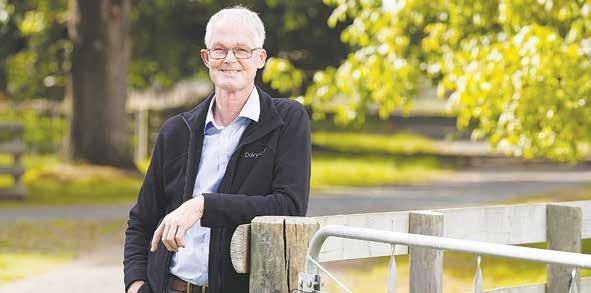
This includes support ing flexible immigration policies and our sector’s Great Futures in Dairying Plan (designed to build great workplaces and workforce).
In many ways, we want the same things as other Kiwis – a solution to the crippling rates of inflation and workers to fill vacancies.
We want solutions that work for the people in our rural communities, so they can thrive and continue contributing to a positive future for New Zealand.
WEST COAST dairy farmer and Holstein Friesian breeder Alex King has innovation and adaptability in his blood.


Not only did he relocate to New Zealand with his parents as a child, but the challenging land on which his farm was established led to the creation of a soil management method that was named after his family.
Alex emigrated from Scotland in May 1963 with parents Fred and Jean, and brother Tom.
“My parents owned a small farm in Scotland, but Dad had an uncle in New Zealand so that’s where the attraction to emigrate lay,” Alex says.
They moved to Westport in 1969, with Fred working as a Ministry of Agriculture inspector.
Alex attended Lincoln College in 1972, but after 18 months of studying for a Bachelor of Agricultural Science he decided it wasn’t for him. He returned to Westport and did contract gorse spraying for Land & Survey, fencing in winter, and a little bit of shearing.
Brother Tom joined Alex in 1974 to establish the King Brothers farm
business. They leased an ex-town supply farm on the outskirts of Westport and started dairy farming in 1975.

They started with a crossbred herd, buying their first purebred Holstein Friesian heifer in March 1976 from Nelson and Jan Cook’s Westland Stud. They bought 13 animals in total at the first sale, mostly by the bull Spreydon Lodge Kerk.
“They were good producers,” Alex says. “We went on to buy more heifers each year to top up our replacements, buying 60 in total.”
The herd was improved following the introduction of the Cooks’ bloodlines that Nelson was generous enough to share, Alex says.
“I really appreciate Nelson’s keenness to share his knowledge, and we’ve become good friends over the years,” he says. “He has been an inspiration and a mentor.”
In 1984 Alex went into the ballot system for farms at Cape Foulwind on the West Coast. The original plan for the Cape was for 48 dairy units, milking 135 cows each.
“Unfortunately, due to Rogernomics the first year of ballots was the last,” Alex says. “But I got an 111ha farm, which was the original trial farm on which they planned to see if dairying was viable on the Cape.”

The farm hasn’t been without its challenges.
The heavy pakihi soil –which has a solid iron
■ Owners: King
pan between 300mm and 1m below the surface – became very wet in winter as it got waterlogged and could not drain away.
“In some areas we were able to push posts in by hand,” Alex says. “Humping and hollowing the land seemed to help, but it did depend on the soil and gravel types.”
In 1990 the family was undertaking digger work on farm when Fred suggested they dig deeper to see what was underneath. The resulting method of flipping the soil was later renamed the ‘King Flip’ after the family.
Flipping the soil involves digging the soil
■
to a depth of 1-4m, partly inverting and mixing it and breaking up the iron pan to improve drainage and fertility.


Alex says with no aerial topdressing, ground spreading became the norm and wintering cows on was a plus.
“The organic matter built up over the years, but some areas had to be reflipped as they weren’t flipped deep enough early on,” he says.
MATING OF the milking herd starts with four-and-a-half weeks of AI, before tailing with Hereford bulls, which they have done for the last 12 years.
Alex trained with Ambreed in 1981 and still AIs the larger herd himself.
The Kings breed their own bulls, using Hereford yearling heifers from Lake Station. The bulls go with the dairy heifers to the grazier.
The heifers are run with high BW Jersey bulls, from which they keep 15 calves.
With fertility and somatic cell count (SCC) the main drivers, Alex says the “ducks are starting to line up”.
“Last season, the small herd had a seven percent empty rate, and the larger herd had an 11 percent empty rate, at 10.5 weeks,” he says.
The breeding of the Garvocklea herd has been made up of many careful decisions over the years. The herd’s genetics have a strong foundation, starting with the use of Nelson Cook’s bloodlines back in the 1970s.
Alex bred his first VG-classified cow in the late 1980s, Garvocklea A F Rose.
“Her dam came from Nelson Cook and her sire was Athol Sovereign Fame,” he says.
Following an inspirational talk from the 1988 Holstein Friesian NZ Blenheim conference keynote speaker, Alex started using a son of Puget-Sound Sheik - Kauri Ridge Sheik Calypso - and Athol Fame Prefect.
“We wanted functional type cows, and because the pakihi soil was daunting in the early years we decided to breed a lighter cow,” Alex says. “Hence the use of the Pukeroro bulls for the first five years.”
Alex also used one of Gordon Stewart’s (Cresslands Holstein Friesians) Pukeroro-bred bulls over Garvocklea A F Rose, from which he got a heifer calf that became Tobias’ calf club calf.
They have also started using World Wide Sires outcross genetics to see how overseas genetics may fit into their farm system.
“With the Jersey genetics we used way back then, it is fair to say that nearly half the herd carries some Jersey blood,” Alex says. “But Holstein Friesian genetics keeps the udders correct.”
Alex was a member of Holstein Friesian NZ in the early 1990s, but registration of cattle fell away as “we weren’t selling surplus stock”.
However, with daughter-in-law Christie being an AI technician and keen on genetics, they ended up classifying 110 cows in the 2021/22 season. To their surprise and delight, they gained two EX and 40 VG classifications.
“It has sparked even more interest,” Alex says.
“I am still a stalwart of the Holstein Friesian breed.”
DAIRY FARMERS will be paying a higher TB differential slaughter levy from next month despite concerns raised by DairyNZ.
The new differential slaughter levy rates are: $11.50/head for dairy animals, up from $10.50/ head and $4.75/head for beef animals, changing from $5.50/head.
There will be no
changes to the deer industry levy.
The levy is collected to support funding of the TBfree programme on behalf of beef and dairy industries. The funding shares change annually based on shifts in each industry’s relative size and value.
Ospri says each year the levy rates are reviewed under the TBfree Funders
■ Keep your NAIT account up to date. This includes recording movements on and off your property and reviewing animal production type for any livestock being consigned to slaughter.

■ If finishing dairy animals as beef, the production type must always be updated in the NAIT system 62 days before sending to slaughter; otherwise the animals will be charged the dairy levy.

■ For untagged animals, the meat processors will use the primary farm level (NAIT number) production type for charging the TB slaughter levy.
■ For unregistered animals, the meat processors will use the tag level production type for charging the TB slaughter levy.
Agreement to ensure that the overall funding of the TBfree programme aligns with the agreed funding levels.
Levies are adjusted
to reflect the latest industry farm gate values and slaughter volumes for both dairy and beef stock.
It says while fully supportive of the TB Programme, DairyNZ
expressed concerns the timing adds further pressure to farm businesses currently challenged by the reduced milk price.
In making its decision, the Ospri board acknowl-
edged that all farmers are under financial pressure, but if the differen-
tial slaughter rates are not recalibrated now for the dairy levy, there
would likely be a need to increase this rate by greater increments in the future.
“Any adjustments to the differential slaughter levy are communicated to DairyNZ, Beef + Lamb New Zealand, and Deer Industry New Zealand as the industry levy bodies in the TBfree Funders’ Agreement and are made in line with the annual funding level specified,” it says.
“Adjustments in differential levy rates do not provide an overall increase in the annual funding of the TBfree programme — but do ensure consistent funding to enable the programme to deliver.”
A NEW TB slaughter levy has been in place since July 2016. From 1 October 2023, the new differential slaughter levy for dairy cattle will be $11.50 per head. The beef cattle levy remains at $4.75.
The TB differential slaughter levy is collected to support funding of the TBfree programme on behalf of beef and dairy industries, and the funding shares change annually based on shifts in the relative size and value of each industry.
How do I make sure I pay the correct rate?
The levy is managed by assign -
ing the correct animal production types in the NAIT system. Account holders can assign their required production type, dairy or beef, which determines what levy is charged at the time of slaughter.
When farmers are tagging and registering their animals, they select the correct production type for their livestock in the NAIT system.
When purchasing animals, farmers need to make sure animal production types are correct after the movement onto their property is confirmed.

If an animal’s production type is dairy when it is sent to slaughter,
the farmer will be charged the dairy levy for that animal.
If the production type of the animal is changed from dairy to beef – and stayed on a beef farm for more than 62 days – the farmer will be charged the beef levy. When buying animals on a regular basis, a livestock agent or information provider might help with updating the production types of animals.
For untagged animals, meat processors use the primary farm level (NAIT number) production type to determine what levy rate should be charged.
WITH AGRITECHNICA
2023 just around the corner and a reputation for getting grass knocked over quickly, German manufacturer Krone has released details of two newcomers to their butterfly mower conditioner range in the shape of the EasyCut B1050 CV (Collect) and the EasyCut B880 CV/CR (Collect).
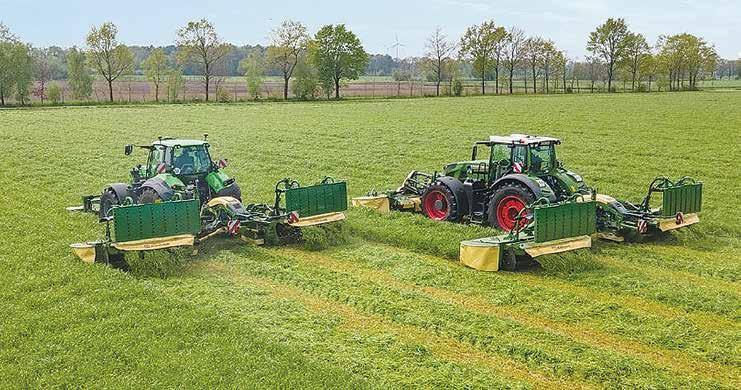
When matched with a 4m front mower unit, the maximum cutting width of the larger machine is 10.45 metres.

Both mowers are equipped as standard with the EasyCut cutter bar that is protected from impact damage by the SafeCut system that incorporates a shear pin
that breaks and allows the cutting to wind itself upwards to leave the ‘danger zone’.
While the mower support arms on the B880
are adjusted mechanically into two fixed positions for a working width of 8.52m or 8.72m, the B1050 features hydraulic adjustment to provide
stepless working width adjustment from 9.30 to 10.45m.
Both mowers are equipped with hydraulic cross conveyor belts to

create a swath – a format said to be ideal in light crops and whole crop silage – with belt speed being adjusted from the cab and offering the

option for the belts to be switched on or off individually.
Alternatively, swath merging on the EasyCut B1050 CV can
be achieved with the optional Big-Swath auger conveyors that are also found on the Big M selfpropelled units and using 45cm-diameter augers behind the CV conditioner.
The B880 CR (Collect) is also available with roller-conditioner units for leafy crops, such as lucerne, while hydraulic functions of the B880 CV/CR include lifting the mower units on one or two sides or swivelling the cross conveyor belts in and out, can be preselected electrically as standard.
For ease of operation, transport height of the two mowers is under 4m, with both units unhitched and parked on hydraulically telescoping support jacks.
@dairy_news

facebook.com/dairynews
WITH A working width of up to 9.50m, the Claas Disco 9700 butterfly disc mower is available in five versions with the choice of tine or roller conditioner units and swath merging.

Combining Max Cut mower beds with quick knife change and the Active Float suspension, new features include the flow-optimised wear skids-first seen on the Disco 8500, 9300 and 1010 in 2022-offering the ability to increase cutting height by 15mm.
New swinging arms on all 9700 models can be hydraulically extended laterally by 300mm or pulled inwards by 50mm to adjust the cutter-bar overlap when turning corners or working
across slopes, helping to avoid unmown strips of grass. The swing arm travel can be infinitely adjusted from the cab between 8.80 and 9.50m. When folded into transport position, the arms automatically retract to a height of less than 4.0m.
Suitable for tractors of up to 500hp, the 9700 RC (roller conditioner) and Auto Swather versions are specifically developed for lucerne and whole-crop silage, where material is gently crushed by two counter-rotating polyurethane rollers, with minimal leaf shatter. One, or both belt units can be folded up hydraulically when working without swath merging.



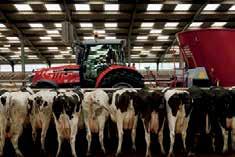






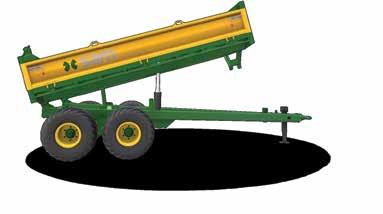
Capacity or the High-Capacity and Pre-cutting feeding system.
WITH THE launch of the new John Deere 1 Series Round Balers, New Zealand round bale producers will now be able to document bale moisture and weight in near real-time, using innovative Bale Doc technology.
In addition to optimising moisture and ensuring consistent bale weight, Bale Doc also sends data to the John Deere Operations CenterTM for post-harvest analysis, helping operators to make informed decisions about key production factors such as nutrient management and reducing input costs.
The new 1 Series Round Baler line-up includes the 451M, 451R, 461M, 461R, 561M and 561R. The “E” designation signals a regular pickup, the “M” shows the baler is equipped with the MegaWide™ Plus pickup, and the “R” model shows the round baler is equipped with the High-
Options include Net-Lift Assist to deliver a 90% reduction in lifting effort as the connecting linkage attaches to the net wrap handles and the roll is moved into position.
Net Lighting illuminates the net wrap and wrapping components and a Preservative System that utilises a tank, sensors, controller and distribution system ensures the right amount of preservative is applied to each bale.
Operator fatigue is reduced using the integral Baler Automation system that opens and closes the tailgate at the right time, eliminating repetitive tasks, reducing operator error and minimising down time, helping farmers produce bales as quickly as possible.
A new, standard 8-inch G5e display provides operators with an easy-to-learn, consistent experience, giving them total visibility and control over baling operations. The 1 Series also features a new optional
High-Capacity Pickup, which internal testing showed could pick up and feed crop with up to 33% increased capacity compared to previous models.
Speaking to the technology in the 1 Series, John Deere production systems manager, Stephanie Gersekowski, said the aim was to deliver consistent, high-quality bales for hay operations of all sizes.

“Our customers have told us reliability, serviceability and productivity were three key factors they considered when selecting a new round baler,” says Gersekowski.
“Providing near real-time moisture and weight data, in addition to bale count and other agronomic data, the information will allow operators to monitor and track bale location and baling conditions, while remote managers can leverage this data to more effectively plan workflow and logistics to save time and money. Every bale recorded through Bale Doc is like a mini-income statement for your entire production cycle.”
WHILE NEW Zealand might not have the hills associated with Switzerland, the concept of a self-propelled round baler makes an interesting proposition.

Over in Europe, Swiss farm machinery company Lisibach Maschinenbau, already known for buiing static maize balers and wrappers, has pulled out the stops to meet customers special requests, with their SF 132, whose wide tyres and low centre of gravity, allow it to operate on slopes of a “buttock-clenching” 45 degrees.

Described as compact, manoeuvrable and with a low weight of around 6.0 tonnes, the

high-output machine is said to be ideally suited to working in small or wet fields, typical of the region.

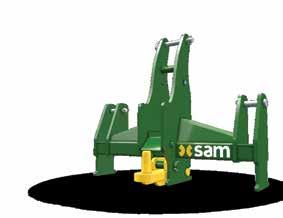
Power for the project is supplied by a 4.4litre Perkins 92kW/132hp four-pot block – hence the 132 designation. Configured with front wheel steering, all four wheels are powered, while the four-range hydrostatic transmission
offers a maximum speed of 40 km/h. With an overall length of length of around 5.0m and a height and width of about 2.5m, the centralpivoting chassis allows the machine to turn sharply on headlands. Operation is via an armrest mounted joystick, with the cab providing heating, air conditioning, a Grammar air suspended seat, radio and a
cooled drink holder. The SF 132 is the fourth machine that Lisibach has built, since making the first for its own contracting business in 2005, utilising a Welger RP235 baler. That same baler was used for the contractor’s second machine in 2013, with another machine built in the same year for a Swiss farmer, based on a Kuhn I-Bio baler/wrapper combi. The latest incarnation is mated to a Kuhn FB 3135 fixedchamber baler. Dairy News understands that Lisibach charges around €250,000 (NZ$455,0000) for the SF132, without the price of the baler.
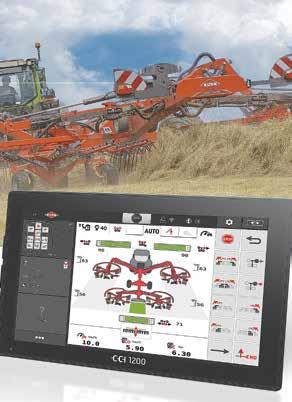
THE KUHN GA 15131 rake, with a working width of 9.50 to 14.7 metres, currently holds the world record, established in Denmark in 2019, for raking output, where it was able to rake 188.9ha in only 8 hours.
The GA 15131 rake and its smaller GA 13131 brother have morphed into the 10231 series that feature numerous upgrades.
Recognisable by the GA 13231 and GA 15231 designations, the fourrotor, central delivery rakes offer working widths from 8.4m to 14.7m.
Major developments include new electronic architecture, which incorporates the new ISOBUS M500 module, the latter more powerful, with more capacity and offering more possibilities than the former model.

The ISOBUS terminal interface for the machine’s control has also been redesigned to more user-friendly, including generating graphic icons related to the various functions for use with the ISOBUS CCI A3 joystick.
Other upgrades include individual working width adjustment as standard, while the suspension of the front
rotors is now carried out via hydraulic cylinders allowing a more precise adjustment.
Automatic ground pressure adjustment is possible depending on the working width. These two key features allow the user to easily adjust the machine to the working conditions, minimising dirt ingress and preserving the sward.
Other improvements include a new adjustment of the working height control, a new hydraulic block with new electronic management, alongside new sensors throughout for improving precision and system diagnosis.
All the features that have made the KUHN four-rotor rakes popular have been retained, including the exclusive 100% hydraulic drive system, that allows perfect adaptation of rotor speed to the forage type and yield, while minimising maintenance work.
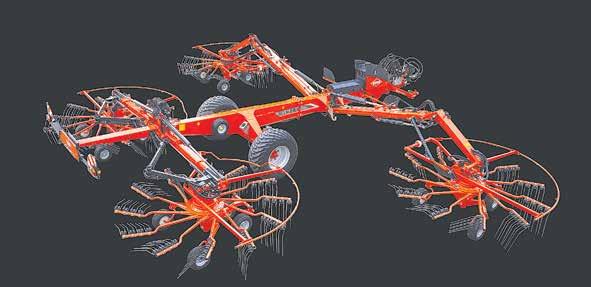
The BOOST function improves windrow quality by increasing the speed of the front rotors by 20% compared to the rear rotors to build a homogeneous and airy windrow.
The individual rotor lifting allows operators to avoid obstacles and adapt work to the changing shape of the paddocks.
1) Next-level versatility
Feeds rounds or squares, tight or loose - BaleXpress feeds out any type of bale
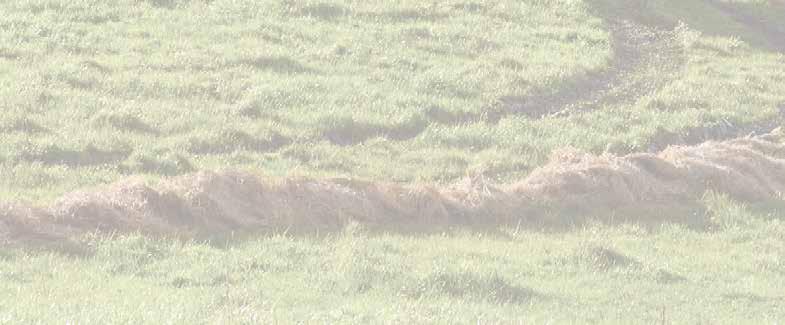









































2) Easier, faster & more convenient loading





Fewer trips & fewer movements - BaleXpress will save you time and energy
3) Compact design

A big machine in a compact form is easier to manoeuvre and navigate gates and tight corners - also easier to load from either side or rear

4) Simplicity & reliability
Fewer moving parts means fewer points to break down, so BaleXpress has been designed for maximum effi ciency with less maintenance


SEE OUR LATEST NZ MAILER
LEARN MORE hustlerequipment.com/balexpress


LAST
CHAINLESS TE205

Trailed Round & Square Two Bale Feeders



> Feeds out ANY type or shape of bale





> Total Control loading system












> Also available in a mounted version


> No feed chains NOW FROM $23,660+GST



LOADMAX TIP TRAILER RANGE





See our new LoadMax Tip Trailers in 8, 10 & 14 tonne capacities




FROM $33,990 +GST
LEARN MORE at hustlerequipment.com/loadmax
AN ONLINE feed sourcing and delivery platform, Feed Finder, has been launched to help farmers.
Future Farm Systems, which is behind the digital platform, claims it is revolutionising the feed sourcing game for New Zealand farmers.

Feed Finder offers farmers the convenience of a one-stop-shop for feed sourcing, automatic pricing calculations, and reliable delivery management, it says.

By collaborating closely with feed growers and contractors nationwide, Feed Finder ensures that farmers have access to everything they need to make informed decisions. From detailed feed specifications and highquality photos to comprehensive nutritional feed testing, Feed Finder standardises feed listings, eliminating the need for time-consuming calls to multiple suppliers and transport companies, the company says.
Dave Meaney and Greg Johnston, the founders of Future Farm Systems, says they are passionate advocates for the dairy farming industry and the vital role it plays in NZ’s economy.
“Dairy farming is the backbone of New Zealand’s economy, generating a staggering $22 billion in export revenue. Our focus on feed and pasture, two of the largest expenses and critical profit drivers for farmers, led us to the creation of Feed Finder,” says Meaney.
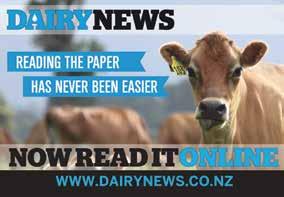
“The feed industry’s fragmentation posed a significant challenge, which Feed Finder is uniquely positioned to address.
“The platform simplifies feed sourcing and delivery, ensuring that supplementary feed not only arrives on time but also contributes positively to animal health, productivity, and overall farm profitability.”
Johnston says they have worked alongside farmers and suppliers to build the platform.
“Our dedication to continuous learning drives us to help farmers make informed feed decisions and streamline the challenges of getting feed on farm.”
He says Feed Finder has partnered with a network of rural contractors to serve farmers.
“Furthermore, a strategic collaboration with Hill Labs enables Feed Finder to streamline feed testing, providing farmers with unparalleled clarity about the feed they acquire.
“In an industry where farmers face daily complexity, and decisions can change in the blink of an eye, Feed Finder by Future Farm Systems stands as a beacon of innovation, simplifying the lives of dairy farmers across the nation.”
Tahuna farmer Tom Bebbington, who milks 300 cows, has used Feed Finder.
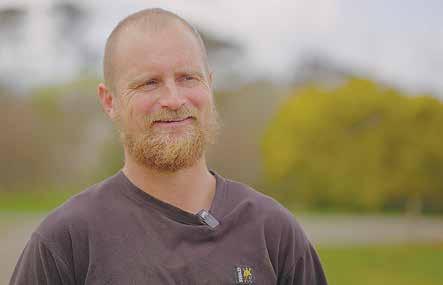
“I was in a pinch leading to balance day and I needed a couple of loads of silage fast. I had seen
Feed Finder on Facebook so jumped on and found some silage in Cambridge which fitted my requirements.
“I let Feed Finder know how quickly I
needed them, and I had the first load on the farm within a couple of days.
“I am excited to see how their journey plays out and what they come up with.”
“I am excited to see how their journey plays out and what they come up with.”
construction, testing, measurement and inspection technology.
THE TECHNOLOGY and Innovation Centre (TIZ 3) at Grieskirchen in Austria was founded in 2002 and is operated by three shareholders.
Pöttinger, as the lead company, is running a state-of-the-art research and testing centre, offering prototype


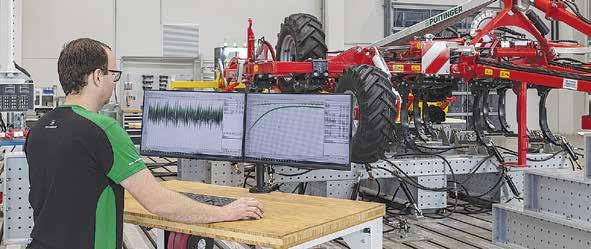
The latter is used not only for Pöttinger’s agricultural machinery, but also for running pilot projects for external customers.
During development of agricultural machinery, the test centre has the task of generating knowledge for the transfer to series production and collaborating with testing companies to guarantee the best possible working result. Additionally, durability testing is carried out on the test beds that cover the full-service life under operational conditions such as those found in the field.
A recent expansion at the Centre provides 1800m² of additional floor space; 1300m² of this is dedicated to testing technology, with the remainder for prototyping, with equipment that
WELL KNOWN European brands Sulky, Sky and Prolog have been brought together under a single brand called Sky Agriculture, ditching their blue, green and red colour schemes for a new graphite grey and titanium white corporate look.
All part of the Burel Group, the company is looking to build on record net sales of €85 million for the 2022-2023 financial year, suggesting that the single-brand strategy will enable it to adapt to the changing face of agricultural equipment distribution in Europe in a market that is becoming more concentrated.

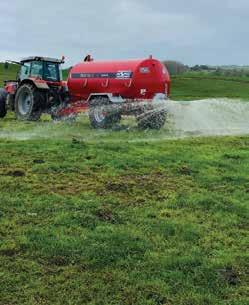
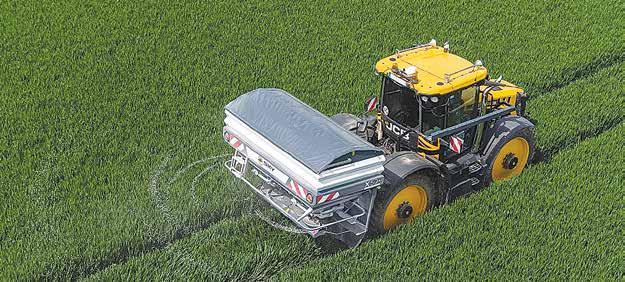
includes a 360m² component testing station for individual test bed setups.
Described as using the most modern component testing equipment in Europe, the Centre also provides access to test scenarios for e-mobility including testing of highvoltage components.
Markus Baldinger, Pöttinger managing director, explains that in addition to investing in modern production plants, the company has a strong focus on testing and inspecting agricultural machinery.
“This additional investment in TIZ 3 sees us fulfilling our promise to our customers regarding high quality, strength, reliability and durability.
“The tests that simulate real operating conditions save up to 75% of the time and costs compared to practical tests performed in the field.”
The creation of Sky Agriculture is also intended to support the group’s export growth, that currently sees around 40% of production sold outside of France, with a short-term aim of pushing this to 50%.
Dairy News understands that the first Sky Agriculture branded machines are already leaving the group’s four production sites of Carvin, Fontenay and Chateaubourg in France, and Osasco in Italy, with the new look to be publicly showcased at the German Agritechnica Event in November.

A CUSTOM-BUILT, eightrow, linkage-mounted precision planter is enabling Hamish Golden, a South Catlins-based ag contractor, to direct-drill a range of forage crops without any loss in accuracy or yield potential.
The unit comprises eight Kinze 3005 row units, each fitted with Ag Leader’s high-tech SureSpeed metering and SureForce downforce regulation systems and mounted to a customdesigned three-point linkage tool bar, with 15 to 20-inch rowing spacing for different crops.
SureSpeed is an integrated 1.7 or 3-bushel hopper, singulation, metering and powered delivery system that achieves precise seed placement at any operating speed from 2 to 19 km/h, placing the seed in the furrow at the same speed as the tractor. SureForce automatically adjusts the downward or upward pressure in each row unit to maintain a consistent planting depth across varying soil types and planting conditions, using dual-acting hydraulic actuators that produce up to 295kg of downforce and up to 115kg of uplift. Both systems are controlled using the Ag Leader InCommand display, which also controls the tractor’s auto steering system.
The unit was constructed by long-standing friend, Spencer Marshall, who also operates a precision planting business each summer. The machine’s row units were sourced from the US, the SeedCommand equipment from Un Earth Ag in Rotorua and the display and steering systems from Advance Agriculture in Gore.
“All told, the planter cost about $225,000 to construct, excluding labour; more than you’d pay for a conventional planter, but there is nothing like it in the country,” Hamish says.
Finished in midNovember, the planter was immediately put to work planting a 2.7ha swede crop on Hamish’s 400ha family sheep and deer farm. The crop yielded about 20 t/ha, with test runs at speeds of up to 17 km/h achieving the same placement accuracy as the more usual drilling speed of 8 or 9 km/h. Hamish went on to plant 325ha of forage crops across 36 Southland and West Otago farms over a hectic eight-week period last summer.
“To be honest, it was a bit stressful trialling a new machine,” he says. “We have a few issues but two of them were my fault. Everyone held their breath for a few weeks, but the crop emergence was perfect.”
After working in the US, Spencer Marshall returned to NZ just as fodder beet was starting to take off. It had had to be precision planted but as the nearest contractor was 50km away, he saw an opportunity and set up his own contracting business in 2016. Today, Precision Direct Drilling plants more than 800ha of forage crops throughout Southland and West Otago each summer.
After initially running a modified six-row mounted maize planter, Spencer set about building his own precision planter. The trailed unit has a folding tool bar carries 12 Harvest International 1N row units and a three-tonne fertiliser hopper. Adjustable from 15 to 20-inch spacings, it offers an operating width of 4.5 to 6 metres.
Spencer notes, “I specifically wanted a trailed machine for greater visibility in front of the tractor, a large hopper and the ability to direct drill a range of crops”.
Once again, each row unit is equipped with Ag Leader’s SureDrive electric drive and SureForce hydraulic downforce systems. SureDrive automatically adjusts the speed of the planter’s existing meter to maintain a con-

stant planting rate around turns and precise end-ofrow shut-off. Each row unit is completely independent in terms of its metering and downforce.
“You can waste a lot
of seed, particularly when you’re not working in a nice, squared-shaped paddock, so I estimate I’m easily saving 10% in seed costs for my clients.”

1: Collision Safety System:
If the mower happens to encounter an obstacle, the design of the hinge enables the mower to move simultaneously backwards and upwards to ride over the obstacle. Once the obstacle is cleared the mower automatically returns to the cutting position.
3: Hydro-pneumatic suspension:

The advanced suspension system ensures that the ground pressure is consistent across the entire cutterbar, resulting in a precise and clean cut.
2: Disc Drive Safety System:
The unique solution of four brass shear pins protects the cutter bar gears from impact and subsequential damage. This effective but simple solution enables the mower to be repaired easily and cost-effectively in the field, often by the tractor driver.
4: Three Year Warranty:

The SIP SILVERCUT range of mowers come standard with a full Two-Year Warranty, plus an additional third year of warranty subject to regular dealer servicing, resulting in worry free operation.

SIP has a SILVERCUT mower to suit every farming situation
